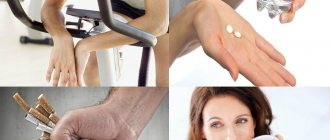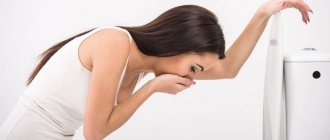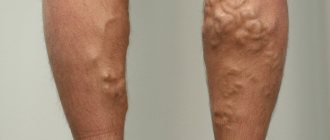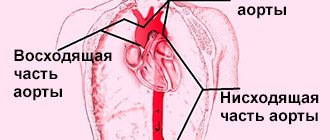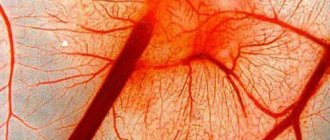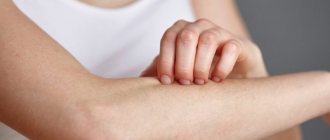Elena Anatolyevna Bardukova, neurologist, homeopath, 23 years of work experience ✔ Article verified by a doctor
Famous Japanese rheumatologist: “IT’S MONSTERAL! Russian methods of treating joints and spine cause only bewilderment. See what doctors offer to treat your back and joints in Russia: Voltaren, Fastum gel, Diclofenac, Milgamma, Dexalgin and other similar drugs. However, these drugs DO NOT TREAT JOINTS and BACK, they only relieve the symptoms of the disease - pain, inflammation, swelling. Now imagine that..." Read the full interview"
The article explains how to treat VSD and panic attacks, what they are, and how to prevent attacks.
Autonomic dysfunction and its symptoms are not a consequence of a problem with your internal organs, even if you clearly feel pain in your heart, stomach or head. People who resort to medical examination in such cases leave medical centers with results that do not clarify their situation: no abnormalities in the functioning of the organs were identified
And now you are completely healthy, but at the same time you feel disgusting, experiencing pain, breathing problems, loss of strength or even panic attacks. What to do in such a situation?
Autotraining and psychotherapy
Appointment with a psychotherapist
It is very important for a patient suffering from vegetative-vascular dystonia and panic attacks to be able to cope with stress on their own and to master self-hypnosis techniques that can reduce the symptoms of VSD. Psychotherapy is a very important method of treating VSD. Before starting to take antidepressants, the patient should contact a competent psychotherapist who will explain to the patient the essence of his disease, will definitely emphasize its benignity, favorable prognosis, and teach methods of dealing with stress and relaxation.
And, perhaps, the patient will do without the need to take medications. The ability to properly relax, positive thinking, and breathing therapy methods can have a much greater effect in the treatment of VSD than simply taking medications.
How to fight on your own?
A panic attack is a fear associated with various types of phobias. People suffering from PA fear suffocation, contracting an incurable disease, choking and dying. And these fears concern not only oneself, but also extend to all relatives and friends.
Many things can trigger a panic attack:
- accident;
- death of a loved one;
- stress;
- staying in a confined space;
- overwork.
After the first incident, the attacks begin to recur and, worst of all, every day at almost the same time. Unfortunately, the subconscious forces you to wait for this moment to arrive, worry and begin to fear the onset of another panic attack. This leads to the fact that the person suffers the attack even worse and cannot fight on his own. In the meantime, you need to calm down and mentally prepare yourself to alleviate the suffering as much as possible.
A panic attack exhausts and exhausts a person. The body is under terrible stress and must deal with it on its own. The problem of panic attacks and the possibilities of overcoming them were studied and described by psychotherapist Kurpatov. In his opinion, a person suffering from panic attacks needs to understand that these attacks do not kill people, they can be fought on their own. Kurpatov recommends lying down during an attack and accepting death. Accordingly, the panic attack will pass, and a positive effect will be obtained at the psychological level.
Experience of people suffering from VSD with panic attacks
To combat a panic attack on their own, patients with VSD are prescribed drugs that block the production of adrenaline, as well as various tranquilizers and sedatives. In addition to medications, massage and physical therapy are recommended. Based on their own experience, patients claim that there is a positive effect when using massages and physical therapy, while medications do not always help fight on their own. Massages relax and normalize blood circulation. Physical education is recommended due to the fact that during a panic attack, a surge of adrenaline occurs in the body, which allows you to spend various loads, jogging, and exercising on a simulator. In a word, sport stops an attack and allows you to fight a panic attack on your own.
Just what the doctor ordered
Prescription of treatment by a doctor
If the symptoms of vegetative-vascular dystonia and panic attacks seriously worry the patient, panic attacks recur, and psychotherapy methods do not give the desired results, it is time to “involve” drug therapy in the treatment. Novopassit, Tenoten, Afobazol, Persen... Pharmacy kiosks and television advertising offer a wide selection of drugs that put the “nerves” in order and improve well-being. But how not to make a mistake when choosing a drug? Or even prefer treatment with folk remedies?
Patients with vegetative-vascular dystonia, before starting to treat their problem with medication, must strictly follow the following rules:
- Take medications only on the recommendation of your doctor in the prescribed dosage;
- Do not cancel, much less change, one medicine for another during the treatment process;
- If after taking the drug your health worsens, immediately inform your doctor.
Vegetovascular dystonia
How to get rid of VSD and panic attacks? With vegetative-vascular dystonia, clear theoretical knowledge is extremely important for understanding what is happening to you.
In turn, practical exercises that strengthen the theoretical foundation will allow you to build a happy and healthy life day after day. We'll talk about panic attacks a little later.
Nervous system
How to get rid of VSD and panic attacks? The human body has a nervous system. It consists of regulated and autonomous departments. The first of them, which includes the brain, allows you to speak, make movements, in a word, freely express actions. The second section, the autonomic nervous system, is independent and independent of our desires.
Watch the video (total 12 minutes)
It regulates the functioning of internal organs and secretions and reacts in one way or another to various events, adjusting the body to them. At the same time, different people react differently to the same events because they interpret them in different ways. This position will be key in working on anxiety, but in the future we will return to it, revealing its essence in detail.
"Gas and brake pedals"
How to get rid of VSD and panic attacks? The autonomic nervous system is divided into two sections: sympathetic and parasympathetic. Let's call them “gas pedal” and “brake pedal”. The sympathetic department is responsible for mobilizing the body in the event of some internal or external event, and the parasympathetic department relaxes the body in the absence of any events.
For example, a person is thinking about an upcoming date or exam. In this case, there is no real threat, but adrenaline is still released in the body. When danger or anxious thoughts fade into the background, the parasympathetic department takes over and the person begins to rest.
Flight or fight
How to get rid of VSD and panic attacks? As you know, any person is endowed with the instinct of self-preservation. But sometimes this instinct plays a cruel joke on a person.
It is also important to understand that the basis of the instinct of self-preservation is the protective reaction “Flight or Fight” developed by evolution, inherited from our distant ancestors.
This protective mechanism is triggered in response to danger and is accompanied by the release of adrenaline from the adrenal glands, which puts the body on high alert. Therefore, any exciting situation triggers
the sympathetic department of the autonomic nervous system is the very “gas pedal” that mobilizes the body for survival or escape and creates symptoms.
Unbalanced pedals
How to get rid of VSD and panic attacks? You've probably noticed that when you're anxious, your heart begins to pound faster, in moments of anger your hands tremble and your palms sweat, and when you're offended, your blood pressure spikes. All these are “tricks” of the autonomic nervous system, which in these situations works quite correctly, so you are not afraid of these symptoms. But sometimes the autonomic nervous system begins to “gas” when the situation is not conducive to it.
Watch the video (total 14 minutes)
For example, a person goes to bed, but for some reason the heart rate increases. For some reason, instead of the parasympathetic department, the sympathetic one is activated. At such moments, a person begins to fear symptoms, thereby increasing the overall level of anxiety, which in turn intensifies old symptoms and creates new ones. This is how a person, unbeknownst to himself, falls into a vicious circle of anxiety.
Mythical diagnosis
How to get rid of VSD and panic attacks? Vegetative-vascular dystonia is not a disease, but just an imbalance of the sympathetic and parasympathetic parts of the autonomic nervous system. Vegetative-vascular dystonia manifests itself in the improper functioning of blood vessels, which tense and expand when they need to relax and narrow, and vice versa.
“Vegetative-vascular dystonia is a high level of autonomic nervous tension, when the autonomic nervous system gradually “thinners,” which contributes to the fact that a person begins to feel the symptoms more acutely, but is not yet afraid of them, as with panic attacks.”
Autonomic nervous tension increases due to constant mobilization of the body, i.e. due to the fact that the “gas pedal” seems to be constantly pressed halfway.
It is important to understand: vegetative-vascular dystonia does not exist as a medical diagnosis
You will not find such a phrase in the international classification of diseases of any revision. But many doctors diagnose vegetative-vascular dystonia in the case when they do not know what diagnosis to give to a person, because according to the results of medical examinations he is absolutely healthy, but still experiences symptoms.
The phenomenon of “good medicine”
The best thing you can do when one doctor refers to another, another to a third, etc. after making any diagnoses and after the results of any examinations, is to ask the doctor if there is anything life-threatening, and believe in a negative answer.
It must be remembered that modern medicine does not teach a person how to cope with a particular problem, but only treats him. Even doctors themselves like to joke: there are no healthy people, there are only underexamined ones. Therefore, it is worth clearly understanding:
A healthy person is one who considers himself healthy, and a sick person is one who considers himself sick.
Mental traps of bodily manifestations of anxiety
Despite the versatility of the symptoms of vegetative-vascular dystonia, many people tend to constantly wonder: how can they be sure that the symptoms are not, for example, a heart attack or a sign of insanity. The solution lies in a clear awareness of the differences between psychosomatic and organic manifestations.
Watch the video (only 7 minutes)
Therefore, you do not have to worry that you are suffering from a real disease if the symptoms are constantly changing. This kind of volatility of symptoms suggests that the cause of the unpleasant sensations is simply an increased level of anxiety. It should be understood that there are no guarantees in life, but attempts to get them lead to constant control, which creates nothing but unnecessary stress.
Where do the legs of bodily symptoms come from?
The main cause of the bodily symptoms of vegetative-vascular dystonia is an increased level of anxiety, which arose as a result of increased autonomic nervous tension due to constant pressing of the “gas pedal”.
And this is a consequence of catastrophic thinking and inflated demands on oneself, others and the world. These demands create negative neurotic emotions, including constant anxiety, which always manifests itself physically.
Keys to freedom from symptoms
The bodily symptoms of VSD are not a sign of a real disease, but only a consequence of your distorted worldview, which strains your body.
Key One: Acceptance
All you should do when a particular symptom occurs is accept it, i.e. consciously give up the struggle that causes tension.
Every time, tell yourself that all your symptoms are just a consequence of high anxiety.
Key two: physical activity
A mobile lifestyle and an active life position are important, but not the only way to overcome bodily symptoms.
Movement is life for you and death for your symptoms.
Once you start moving more actively, you will immediately feel good results.
Key Three: Changing Your Mindset
The main element in working on the symptoms of vegetative-vascular dystonia is to eradicate from your thinking the maladaptive habits of catastrophizing, which gives rise to anxiety, and demandingness, which creates anger, irritability and tension.
It must be remembered that VSD is an emotional problem, since emotions always manifest themselves physically.
So always remember this.
Drug therapy
Drug treatment
The following groups of drugs are used in the treatment of VSD and panic attacks:
- Herbal sedatives: valerian, novopassit, persen, motherwort herb. They have a sedative effect and normalize the function of brain structures.
- Tranquilizers: elenium, sibazon, phenazepam, grandaxin. A group of drugs reduces feelings of fear, tension, and anxiety. They can be prescribed before expected stressful situations to prevent the development of panic attacks; the recommended duration of taking the drugs is 2-3 weeks.
- Antidepressants: amitriptyline, imipramine, teralen. The drugs are indicated for depressive disorders and masked depression. Doses of drugs should be individually selected by “titration”: starting with small ones, gradually increasing to optimal ones. As the patient's emotional background stabilizes, the dose of the drug may be reduced.
- Nootropics: piracetam, actovegin, cerebrolysin. This group of drugs improves energy processes and blood supply to the brain in the treatment of VSD; they also improve memory, mental performance; while taking them, the number of panic attacks, if the patient had any before treatment, is reduced.
As a rule, in the treatment of VSD and panic attacks, not one, but a complex of drugs from different pharmacological groups is used. Indications for use, dosage and duration of treatment are recommended by the doctor, individually for each patient.
Causes of panic attacks during VSD
All reasons for the development of panic attacks against the background of VSD are divided into several groups. The group of psychological reasons includes:
- Tensions in the family, separation or divorce.
- Problems at work, stressful work environment, financial difficulties.
- Prolonged stressful situation, depressive or neuropsychiatric personality disorders.
- Loss of loved ones.
Long-term chronic diseases include:
- Arterial hypertension.
- Hypotensive syndrome.
- Cardiovascular failure.
- Coronary heart disease.
- Metabolic disorders.
- Endocrine pathologies.
Reasons that are typical for women include:
- Pregnancy.
- Premenstrual syndrome.
- Childbirth.
- Adolescence.
- The period of menopause.
External reasons leading to the development of VSD include:
- Long-term intoxication caused by the consumption of alcoholic products.
- A sharp change in climatic conditions.
- Consequences caused by drug poisoning.
- Prolonged mental or physical stress.
- Overheating caused by prolonged exposure to the sun.
Etiological treatment
Elimination of causes
At the heart of any disease is a cause, a factor that served as a “trigger” and provoked the onset of the disease. VSD also has the following factors or “triggers”: stress, nasopharyngeal infections, overexertion, hormonal abnormalities. If you influence the elimination of these factors, it is possible to achieve relief from the symptoms of the disease or get rid of it altogether. For example, with VSD and panic attacks provoked by stress, it is necessary to resolve all conflict situations and normalize relationships with friends and relatives.
If the development of VSD is based on an infectious onset, it is necessary to thoroughly sanitize the oral cavity, nasopharynx, and perform a tonsillectomy, if indicated. In case of VSD associated with overfatigue, it is necessary to exclude excessive loads. If a hormonal imbalance is suspected in the occurrence of vegetative-vascular dystonia, then the woman is recommended to undergo treatment together with a gynecologist-endocrinologist.
How to get rid of VSD and panic attacks
The main methods that can help with vascular dystonia with sympathoadrenal crises are non-drug. Among them, a special role belongs to psychotherapy, proper nutrition, breathing relaxation exercises, and physiotherapeutic methods. Medicines are prescribed in short courses.
Nutrition
A dietary diet can help the functioning of the nervous system, providing it with the necessary microelements, vitamins and antioxidants. To do this, you need to include the following products in your daily menu:
- unsalted cheese, cottage cheese, tofu;
- fish of moderate fat content, seafood;
- turkey and veal;
- legumes, bran, brown and black rice, buckwheat, oats (except cereal);
- dried apricots, bananas, avocados;
- leafy greens, eggplant, carrots;
- nuts, vegetable oil;
- citrus fruits, kiwi and sweet peppers.
It is recommended to avoid any artificial stimulants - coffee, strong tea, energy drinks, sugar, alcohol. Strong brews, confectionery products, fatty and fried foods, any canned food, smoked foods and marinades are not beneficial.
Psychotherapy
Taking into account the fact that more and more research results are being received proving that the main role in the development of VSD belongs to disorders of higher nervous activity, panic attacks have moved from the management of cardiologists to psychotherapists. For treatment use:
- family therapy,
- psychoanalytic consultations,
- cognitive-behavioral correction.
As a result, the patient needs to form a strong belief that attacks are not dangerous to life and health, as well as the possibility of preventing and stopping them. It is also necessary to reconsider the attitude towards traumatic situations and identify triggers to neutralize them.
Breathing techniques
Many special types of breathing can be learned by practicing yoga and relaxation and meditative techniques. Even simple fixation on the duration of the phases of the respiratory cycle can smooth out autonomic disorders.
When you feel the precursors of an attack, you need to stretch the length of inhalation and exhalation as smoothly as possible so that the latter is as long as possible. After each breathing movement, a pause of several seconds is needed.
To get the maximum effect, you need to sit comfortably, relax and close your eyes, your back must be straight.
Treatment of sympathoadrenal variant of panic attack
Breathing therapy
A panic attack with a predominance of the activity of the sympathoadrenal system will be characterized by the following symptoms: palpitations, severe headache, chills, general agitation, restlessness, anxiety, panic, tachycardia, increased body temperature. In the treatment of the sympathoadrenal variant of a panic attack, the following methods are used:
- Rational psychotherapy;
- Breathing therapy. The patient must be convinced to breathe “correctly”: switch to a normal rhythm and diaphragmatic type of breathing. It is necessary to breathe deeply, the exhalation should be longer than the inhalation;
- Drug treatment. Intravenous or intramuscular administration of seduxen - 2 ml 0.5%, or droperidol 0.25% 1-2 ml. These drugs relieve anxiety and fear. Anaprilin 0.25% 1-2 ml, administered intravenously, eliminates tachycardia and lowers blood pressure. If the patient is bothered by a severe headache, baralgin 5 ml intramuscularly is effective.
Traditional methods of treatment
Panic attacks are an extremely complex stressful state of a person that plagues him and makes it impossible to sit down or lie down. In addition to the already indicated remedies aimed at curing and alleviating panic attacks, there are a number of folk remedies to fight on your own.
Here's how to deal with a panic attack on your own:
- physical exercise;
- put your feet in hot water and hold them in it for a while;
- pouring cold and hot water over the legs from the feet to the knees;
- breathing exercises that involve inhaling and exhaling into a paper bag and recording everything that happens during the next attack;
- taking herbal decoctions, for example, mint or chamomile;
- prepare and take a herbal tincture, for which you take 4 parts of a glass of lemon balm, 3 parts of a glass of rue, and 3 parts of a glass of thyme, pour the mixture with cold water and infuse;
- prepare a mint infusion from two tablespoons of finely chopped mint poured with boiling water, after two hours, filter the infusion and drink;
- You can prepare an infusion of motherwort from a ready-made mixture purchased at a pharmacy. Or you can finely chop the motherwort yourself and squeeze the juice out of it, the cake is poured with boiling water and after filtering it is mixed with the previously squeezed juice, the infusion is ready for use;
- prepare a honey mixture from two glasses of honey, which is mixed with a pre-prepared infusion of valerian root and dill seeds; the infusion, in turn, is prepared as follows. Valerian root is chopped and two tablespoons are mixed with a glass of dill seeds, then poured with boiling water and left in a thermos for a day.
Attention! To achieve an effect in the fight against panic attacks, it is recommended to take herbal decoctions and tinctures in courses with mandatory breaks for at least two to three months.
Treatment of vagoinsular crisis
Vagoinsular crisis
The vagoinsular variant of a panic attack is characterized by pathological excitation of the parasympathetic division of the ANS. Freezing, interruptions in the heart, sweating, dizziness, a feeling of “falling into nowhere,” decreased blood pressure, redness of the skin, increased intestinal peristalsis—these are all symptoms of a vagoinsular crisis. Psychotherapy and breathing correction are also used in its treatment.
And the medications are the following: atropine 0.1% 1 ml subcutaneously or platyphylline 0.2% 2-3 times a day subcutaneously, for low blood pressure - cordiamine 1% 2-3 ml, caffeine 10% 1 ml. If there are signs of low blood sugar - sweating, dizziness, feeling hungry, a 40% glucose solution of 20 ml is administered intravenously, it is recommended to drink sweet tea. If the patient has severe dizziness and vomiting, 0.5% haloperidol 2 ml intramuscularly relieves these symptoms.
In case of a mixed version of a panic attack, the doctor evaluates from the clinical picture which activity - sympathetic or parasympathetic - predominates, and based on this, forms the treatment. It should be noted that the relief of panic attacks is carried out under ECG control, blood pressure control, it is also necessary to do a blood test for glucose levels, insulin levels, and a urine test for catecholamine levels. The patient, even after one episode of panic attack, must be consulted by a neurologist and psychotherapist.
What is VSD
Vegetative-vascular dystonia is understood as a violation of the regulation of vascular tone by the nervous system, namely its autonomic (autonomous) department. Depending on the predominance of activity, it can have several development options - sympathicotonia, parasympathicotonia and mixed.
Sympathetic effects are associated with the release of stress hormones into the blood, so when their influence increases, the following manifestations will occur:
- pupil dilation,
- increasing metabolic rate,
- increase in blood pressure,
- heart rate acceleration,
- increased breathing rate,
- relaxation of the bladder muscles,
- decreased saliva secretion,
- slow digestion,
- decreased intestinal motility.
Parasympathetic impulses have the opposite effect.
Normally, there is consistency between the departments of the autonomic system. Therefore, there is an adequate response to changes in the internal state of the body or the influence of external factors. With vegetative-vascular dystonia, the balance is disturbed, so stimuli of weak or moderate strength are perceived as life-threatening. One of the manifestations of such deregulation is sympathoadrenal crises, or panic attacks.
We recommend reading the article about autonomic dysfunction. From it you will learn about the types of pathology, the causes of development in children and adults, symptoms and possible complications, methods of diagnosis and treatment.
And here is more about heart pain and neuralgia.
